ブロニスロウ・カスパー・マリノフスキー
Bronislaw Kasper Malinowski, 1884-1942
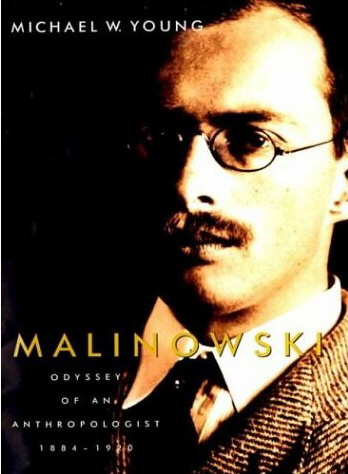
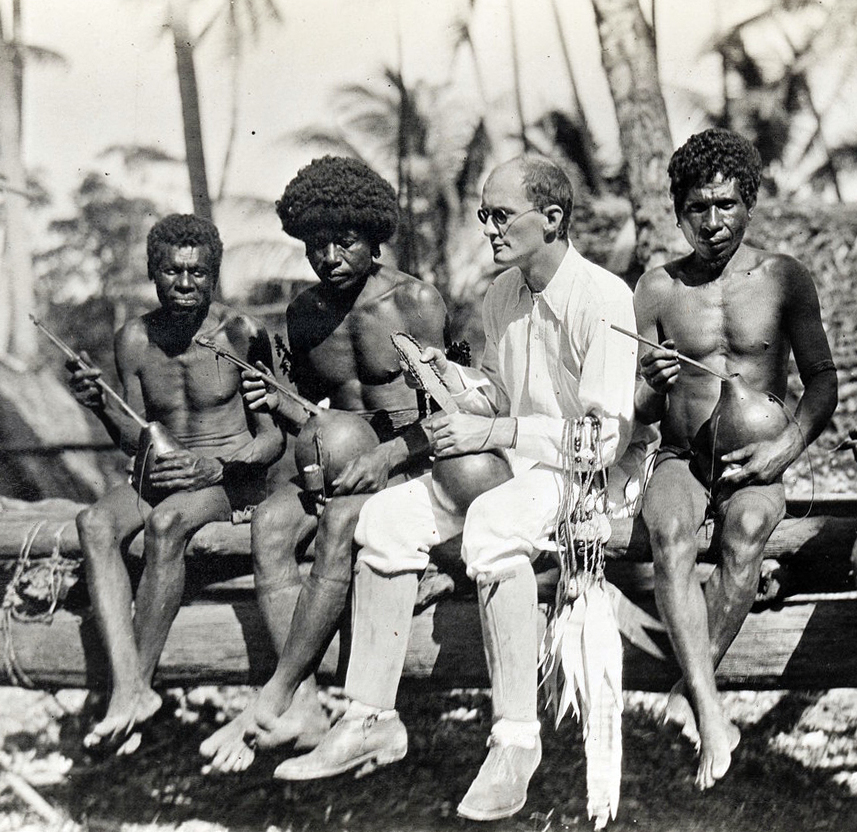
ブロニスロウ・カスパー・マリノフスキー
Bronislaw Kasper Malinowski, 1884-1942


解説:池田光穂
ブロニスロウ(ブロニスラウ)・カス
パー・マリノフスキーは、オーストリアハンガリー帝国領時代のポーランド・クラコフの裕福な家庭の生ま
れの文化人類学者。物理学者として出発したが、ジェームズ・フレイザー(1854
-1941)『金枝篇』(1890-1920)を読んで感動し、人類学への転向を決意したと言われる。しかしフレイザーに師事することなく、ロンドン経済
学院のチャールズ・セリグマンのもとで学ぶ。オーストラリア・アボリジーの親族構造の研究で学位を取り、オセアニア滞在中の1914年の第一次世界大戦勃
発で、オーストリア国籍のマリノフスキーは、イギリスがドイツに宣戦布告したために、敵国扱いになり、マイルー諸島およびトロブリアンド諸島に滞在を余儀
なくされる。同島嶼知識の広範な地理経験をもとに、おもにトロブリアンド諸島のクラ交換について綿密な調査をし、後の『西太平洋の遠洋航海者』
(1922)として結実する——そこで培った参与観察技法は、後の文化人類学者の基本的な調査技法になる。母校の民族学の教師となり、エヴァンズ=プリ
チャードの最初の指導教員になる。1927年ロンドン大学教授になり、数々の著作を発表する。マリノフスキーの社会理論は、機能主義と呼ばれるが、それは
[当時ライバルと言われた]ラドクリフ=ブラウンの構造機能主義[例:親族構造と親族間の情動的関係は相互補完機能をもつ]とは異なり、個人ならびに社会
の心理的充足を促す機能を重視する立場であった。また、トロブリアンド社会が母系社会であったため、当時、精神分析や深層心理で時代を席巻したフロイト理
論が提唱するエディプス・コンプレックスの人類の普遍性に疑問を呈し、トロブリアンド諸島の事例から、それが西洋の父系社会(あるいは父権社会)にのみ説
明可能なものであると異論を唱えた。渡米し、エール大学に滞在中に、米国の研究者とメキシコの市場の研究に従事するが、惜しくも心臓麻痺でコネチカットの
ニューヘブンで58歳で亡くなった。近代人類学の始祖としてのマリノフスキーの影響力は多大で『西太平洋の遠洋航海者』は、長く文化人類学者が書く民族誌
の手本になり続けてきた。このように長く神格化されてきたが、生前の日記が、1967年に
『語の厳密な意味での日記』(A Diary in the Strict Sense of the Term. New York:
Harcourt, Brace &
World.)——日記の文章としてこの言葉が現れる——が出版されるにおよび、彼がトロブリアンド原住民を「黒ん坊(ニガー)」と呼んだり、文通してい
た婚約者とプラトニックな思いを綴るほかに、自
慰のことや、原住民の女性との性交渉をした後に激しく自己嫌悪するなど赤裸々なことが描かれていたために、陰りが見えたことがある。しかし、その後は、マ
リノフスキーの心象風景の中の原住民(先住民)と、科学的な記述としての民族誌との関係についての、さまざま研究が進み、文化人類学研究のパイオニアとし
てのマリノフスキーの地位は不動のように、現在でも数多くの文化人類学者の関心を惹きつけている。【下記にウィキペディア英語の項目からの翻訳がありま
す】
1884 Bronislaw
Kasper
Malinowski(-1942)[Bronisław
Malinowski]、ポーランド、クラコフ(Kraków;
オーストリアハンガリー帝国領)で生まれる。 父、Lucjan Malinowski、母、Józefa, née Łącka.(Bronisław
Malinowski)
1908 物理学と数学の博士号を Jagiellonian大学(クラコフ・アカデミー)より得る。
1908-1910 ドイツ・ザクセン州 ライプチヒ大学(Leipzig University; ヴィルヘルム・ヴント[Wilhelm Maximilian Wundt, 1832-1920]の民族心理学などを受講)
1910 マリノフスキー渡英、LSE(London School of Economics)に入学、チャール ズ・ガブリエル・セリグマン[Charles Gabriel Seligman, 1873-1940]教授に指導をうける(セリグマン門下には、マリノフスキーの他に、エヴァンズ=プリチャード、マイヤー・フォーテスなどがいる;セリ グマンの理論ではもっとも有名なのは聖書から由来するコーカソイドのハム語族文明仮説[Hamites, the Hamitic hypothesis]である)
1913 LSEの社会学部講師
1913 『オーストラリア・アボリジ ニーの家族』The family among the Australian Aborigines: a sociological study. London: University of London Press.
1914.06.28 オーストリア皇太 子フランツ・フェルディナンド暗殺、第一次大戦勃発。
マリノフスキーはポーランド人スタニフワフ・ヴィトケビッチ(Stanislaw Ignacy Witkiewicz, 1885-1939)とオセアニアを旅行中。マリノフスキーはヴィトケビッチを描画家と写真家として連れていっていた。ヴィトケビッチは、第一次大戦勃発 後、帰国してロシア国籍を取得し、しばらくサンクト・ペテルブルグに居住。
1914.09-1915.03 マイ ルー島調査
1915.06-1916.06 トロブ
リアンド諸島調査
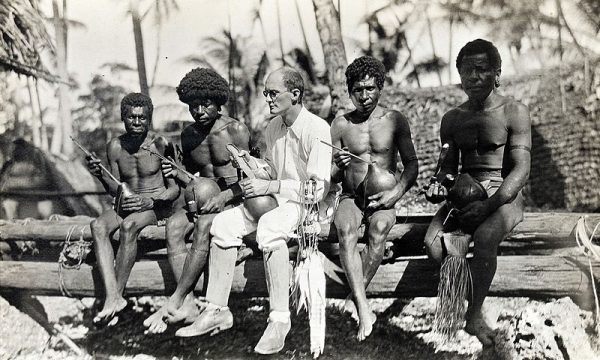
Bronislaw Kasper Malinowski and the Trobriand islanders
1916 博士(D.Sc)取得
1917.10-1918.10 トロブ リアンド諸島調査
1919 エルシー・ロザリン・メーソン
と結婚
1920-21 カナリア諸島テネリフェ 療養、西太平洋の遠洋航海者の執筆に専念。
1921 LSE民族学講師
1922 B.K.マリノフスキー『西太平洋の遠洋航海者』出版
Argonauts of the Western Pacific: An account of native enterprise and adventure in the Archipelagoes of Melanesian New Guinea. London: Routledge and Kegan Paul (Enhanced Edition reissued Long Grove, IL: Waveland Press, 2013)
1924 ロンドン経済学院LSE人類学 講師(リーダー)へのオファー(ロンドン大学からも同様のオファー): Mutterrechtliche Familie und Ödipuskomplex(Imago, Bd. X, Heft 2—3), 1924
LSE院長ベヴァリッジへの彼の回答:
「わたしは社会人類学という名称を提案します。それによってロンドン大学との区別ができます。むこう(=ロンドン大学)は疑いなく『文 化』を主張するでしょう。というのも「文化』はむこうが標榜する言葉ですから。『社会』という言葉は、われわれがおもに社会学的なことがらに関心があるこ とも示します。学院は社会学とそれに関係するいっさいの中心でもあります。社会人類学は、いまではよき英国の伝統も示すことになります。エドワード・タイ ラーがオックスフォードで、フレイザーがリヴァプールで講義したときもこの名称、だったと思います。これによって、未開文化の科学は通常形質人類学と区別 できることになります。「文化』というのはドイツ的ないい方であり、ドイツ語の文化(Kultur)は文明を意味しますが、その正確な意味は英語の文化 (Culture)ではいいあらわすことができません。学院が社会科学の一般教育に適し、たぶんそれを拡大し、現代人文科学との比較のための基礎知識を提 供するためには、人類学あるいは民族学の講座が必要です。そしてもしわたしがまちがっていないとすれば、そうすることがロンドン経済学院(LSE)が存在 する理論的根拠でもあると思われます」(クーパー 2000:43-44)。[鈴木清史訳]
結局、人類学講座のリーダーに就任することになる。
エヴァンズ=プリチャードが最初の学生として入門する。
1925 娘、Helena
Malinowska Wayne(-2018)が生まれる
1926 『未開社会における神話』 Myth in primitive psychology. London: Norton.『野蛮人社会の犯罪と慣習』Crime and custom in savage society. New York: Harcourt, Brace & Co.
1927 マリノフスキー、ロンドン大学 主任教授、『野蛮人社会の性と抑圧』Crime and custom in savage society. New York: Harcourt, Brace & Co.(→参考:ゲザ・ローハイム)
(エヴァンズ=プリチャード、フォー テス、ファー ス、リーチなどを指導)
1929
『北西メラネシアの野蛮人の性生活』The Sexual Life of Savages in North-Western Melanesia. An Ethnographic Account of Courtship, Marriage, and Family Life Among the Natives of the Trobriand Islands, British New Guinea. London.
1930 弟子のマイヤー・フォーテスPh.D取得。
1935 『珊瑚礁と呪術:トロブリアン ド諸島における土地の耕作と農業儀礼の諸方法の研究』Coral gardens and their magic. London: Allen & Unwin.(共著者:E.R. Leach; J. Berry)
1942 エール大学にて、オアハカ調査 を計画中の5月16日心臓麻痺にて、マリノフスキー死亡[58歳]。同年フランツ・ボアズ死去
--(死後出版)--
1944 『文化の科学理論』A Scientific Theory of Culture and Others Essays. Chapel Hill, N. Carolina: The University of North Carolina Press.
1945 『文化変化の動態』
1946 The Dynamics
of Culture Change: An Inquiry Into Race
Relations in Africa. New Haven: Yale University Press.(P.M. Kaberry, ed)
1947 Freedom & Civilization. London.
1948 『呪術、科学、宗教、その他のエッセー』Magic, Science and Religion and Other Essays. Glencoe, Illinois: The Free Press (Reissued Long Grove, IL: Waveland Press, 1992).
1962 Sex, Culture,
and Myth. New York: Harcourt, Brace &
World.
1967 『語の厳密な意味での日記』A Diary in the Strict Sense of the Term. New York: Harcourt, Brace & World.
1993 The early writings. Cambridge: Cambridge University Press.(R.J. Thornton & P. Skalnik, ed)
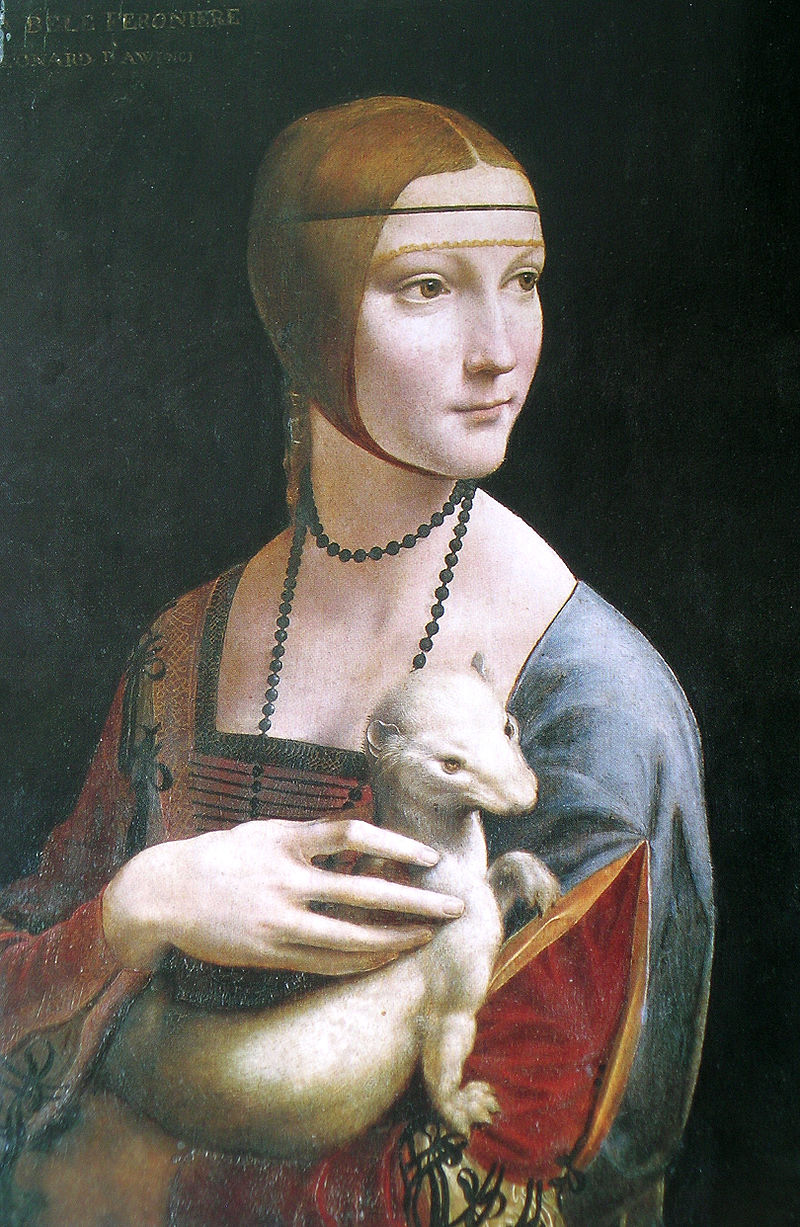
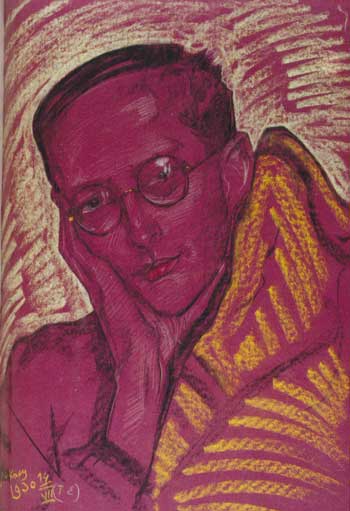
ポーランドのクラコフ(Kraków) のチャルトリスキ美術館(Czartoryski Museum)に収蔵されているレオナルド・ダ・ビンチ「白貂を抱く貴婦人(Dama con l'ermellino)」/ヴィトカシーによるマリノフ スキーの肖像画、1930年
| Bronisław
Kasper Malinowski (Polish:
[brɔˈɲiswaf maliˈnɔfskʲi]; 7 April 1884 – 16 May 1942) was a
Polish-British[a] anthropologist and ethnologist whose writings on
ethnography, social theory, and field research have exerted a lasting
influence on the discipline of anthropology.[10] Malinowski was born in what was part of the Austrian partition of Poland. He graduated from CK III Gimnazjum im. King Jan Sobieski in Krakow. In the years 1902–1906 he studied at the philosophy department of the Jagiellonian University, in the city of Kraków, and received his doctorate there in 1908. In 1910, at the London School of Economics (LSE), he worked on exchange and economics, analysing Aboriginal Australia through ethnographic documents. In 1914, he travelled to Australia. He conducted research in the Trobriand Islands and other regions in New Guinea and Melanesia where he stayed for several years, studying indigenous cultures. Returning to England after World War I, he published his principal work, Argonauts of the Western Pacific (1922), which established him as one of Europe's most important anthropologists. He took posts as a lecturer and later as chair in anthropology at the LSE, attracting large numbers of students and exerting great influence on the development of British social anthropology. Over the years, he guest-lectured at several American universities; when World War II broke out, he remained in the United States, taking an appointment at Yale University. He died in 1942 and was interred in the United States. In 1967 his widow, Valetta Swann, published his personal diary kept during his fieldwork in Melanesia and New Guinea. It has since been a source of controversy, because of its ethnocentric and egocentric nature. Malinowski's ethnography of the Trobriand Islands described the complex institution of the Kula ring and became foundational for subsequent theories of reciprocity and exchange. He was also widely regarded as an eminent fieldworker, and his texts regarding anthropological field methods were foundational to early anthropology, popularizing the concept of participatory observation. His approach to social theory was a form of psychological functionalism that emphasised how social and cultural institutions serve basic human needs—a perspective opposed to A. R. Radcliffe-Brown's structural functionalism, which emphasised ways in which social institutions function in relation to society as a whole. |
ブロニスワフ・カスパー・マリノフスキ(ポーランド語:
[brɔiswaf mali˂ɲ; 1884年4月7日 -
1942年5月16日)はポーランド系イギリス人[a]の人類学者、民族学者であり、民族誌学、社会理論、野外調査に関する著作は人類学の分野に永続的な
影響を及ぼした[10]。 マリノフスキーはオーストリアのポーランド分割統治下にあった時代に生まれた。彼はCK III Gimnazjum imを卒業した。クラクフのヤン・ソビエスキ王を卒業。1902年から1906年にかけてクラクフのヤギェウォ大学哲学科で学び、1908年に同大学で博 士号を取得。1910年、ロンドン・スクール・オブ・エコノミクス(LSE)で交流と経済について研究し、民俗学的資料を通してアボリジニのオーストラリ アを分析した。1914年、オーストラリアに渡る。トロブリアンド諸島をはじめ、ニューギニアやメラネシアの地域で調査を行い、数年間滞在して先住民の文 化を研究した。 第一次世界大戦後にイギリスに戻り、主著『Argonauts of the Western Pacific』(1922年)を出版、ヨーロッパで最も重要な人類学者としての地位を確立した。LSEでは講師、後に人類学の講座を担当し、多くの学生 を惹きつけ、イギリス社会人類学の発展に大きな影響を与えた。第二次世界大戦が勃発すると、イェール大学に赴任し、アメリカに留まった。1942年に死去 し、米国で埋葬された。1967年、未亡人のヴァレッタ・スワンが、メラネシアとニューギニアでのフィールドワーク中につけた個人的な日記を出版した。こ の日記は、その自民族中心主義的で自己中心的な性格から、それ以来論争の的となっている。 マリノフスキーのトロブリアンド諸島の民族誌は、クラ・リングという複雑な制度を記述し、その後の互酬性と交換の理論の基礎となった。彼はまた、優れた フィールドワーカーとして広く認められており、人類学のフィールド方法に関する彼のテキストは初期の人類学の基礎となり、参加型観察の概念を普及させた。 彼の社会理論へのアプローチは、心理学的機能主義の一形態であり、社会的・文化的制度がいかに人間の基本的欲求を満たすかを強調するもので、社会制度が社 会全体との関係において機能する方法を強調するA・R・ラドクリフ=ブラウンの構造的機能主義とは対照的な視点であった。 |
| Biography Early life Malinowski, a scion of the Polish szlachta (nobility),[11]: 1013 was born on 7 April 1884 in Kraków, in the Austrian Partition of the former Polish-Lithuanian Commonwealth – then part of the Austro-Hungarian province known as the Kingdom of Galicia and Lodomeria.[12]: 332 His father, Lucjan Malinowski, was a professor of Slavic philology at Jagiellonian University, and his mother was the daughter of a landowning family.[13] As a child he was frail, often in ill health, but excelled academically. On 30 May 1902 he passed his matura examinations (with distinction) at the Jan III Sobieski Secondary School, and later that year began studying at the College of Philosophy of Kraków's Jagiellonian University, where he initially focused on mathematics and the physical sciences.[12]: 332 [14]: 137 While attending the university he became severely ill (possibly with tuberculosis), and while he recuperated his interest turned more toward the social sciences as he took courses in philosophy and education.[12]: 332–333 In 1908 he received a doctorate in philosophy from Jagiellonian University; his thesis was titled On the Principle of the Economy of Thought.[12]: 333 [14]: 137 During his student years he became interested in travel abroad, and visited Finland, Italy, the Canary Islands, western Asia, and North Africa; some of those travels were at least partly motivated by health concerns.[12]: 333 He also spent three semesters at the University of Leipzig (c. 1909–1910), where he studied under economist Karl Bücher and psychologist Wilhelm Wundt.[12]: 333 [14]: 137 After reading James Frazer's The Golden Bough, he decided to become an anthropologist.[15]: 9 [14]: 137 In 1910 he went to England, becoming a postgraduate student at the London School of Economics (LSE), where his mentors included C. G. Seligman and Edvard Westermarck.[12]: 333 [16]: 162 [8] Career In 1911 Malinowski published, in Polish, his first academic paper, "Totemizm i egzogamia" ("Totemism and Exogamy"), in Lud. The following year he published his first English-language academic paper,[b] and in 1913 his first book, The Family among the Australian Aborigines. In the same year he gave his first lectures at LSE, on topics related to psychology of religion and social psychology.[12]: 333 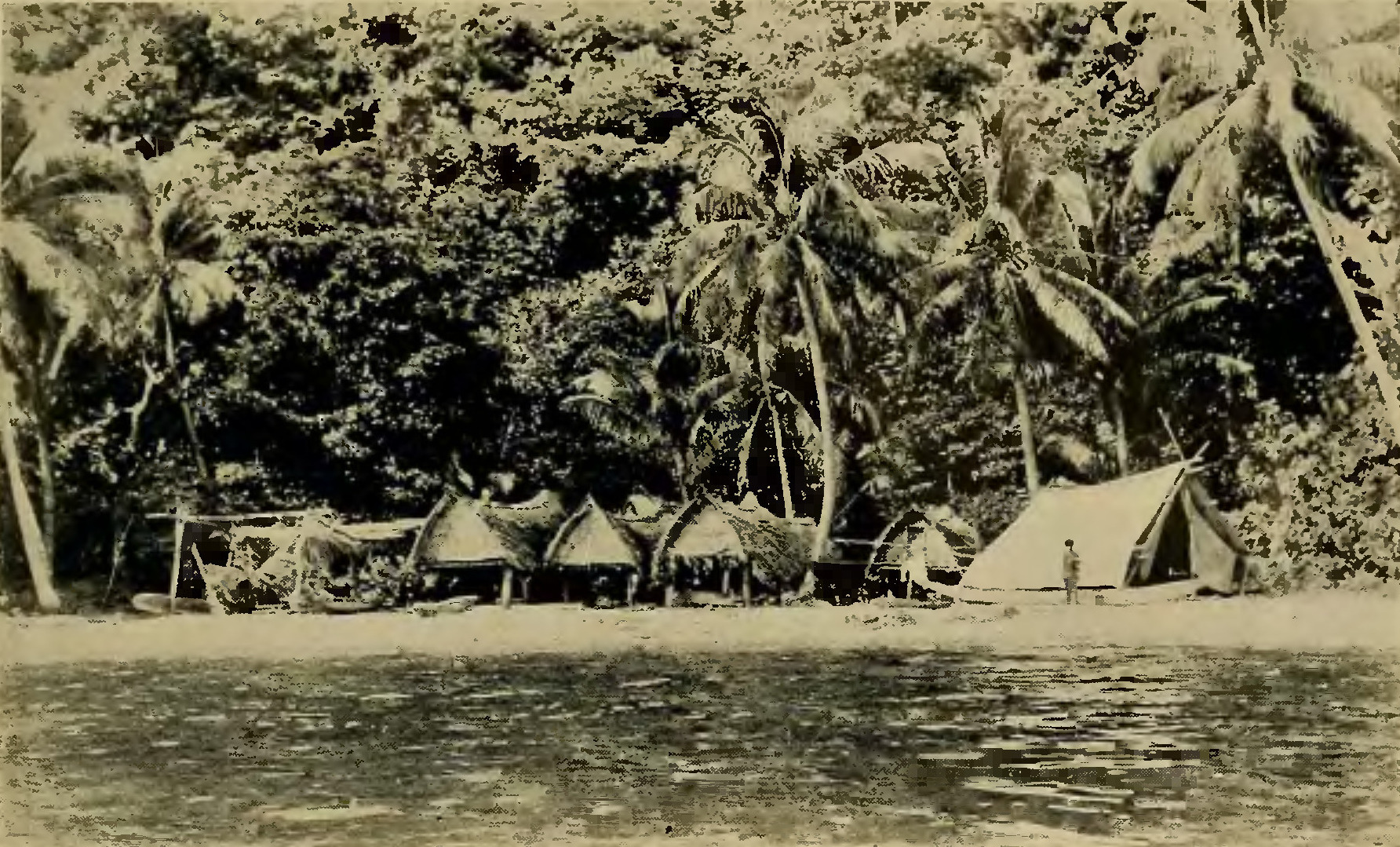 Plate I photo, Malinowski's Argonauts of the Western Pacific (1922), showing a village and Malinowski's tent. In June 1914 he departed London, travelling to Australia, as the first step in his expedition to Papua (in what would later become Papua New Guinea).[12]: 333 The expedition was organised under the aegis of the British Association for the Advancement of Science (BAAS).[12]: 333 Initially Malinowski's journey to Australia was supposed to last only about half a year, as he was mainly planning on attending a conference there, and travelled there in the capacity of secretary to Robert Ranulph Marett. Shortly afterward, his situation became complicated due to the outbreak of World War I. Although Polish by ethnicity, he was a subject of Austria-Hungary, which was at war with the United Kingdom. Malinowski, at risk of internment, nonetheless decided not to return to Europe from the British-controlled region, and after intervention by a number of his colleagues, including Marett as well as Alfred Cort Haddon, the British authorities allowed him to stay in the Australian region and even provided him with new funding.[12]: 333 [14]: 138 [18]: 4–5 [19]: 136 His first field trip, lasting from August 1914 to March 1915, took him to the Toulon Island (Mailu Island) and the Woodlark Island.[12]: 333 This field trip was described in his 1915 monograph The Natives of Mailu.[12]: 333 Subsequently, he conducted research in the Trobriand Islands in the Melanesia region.[12]: 334 He organized two larger expeditions during that time; from May 1915 to May 1916, and October 1917 to October 1918, in addition to several shorter excursions.[12]: 334 It was during this period that he conducted his fieldwork on the Kula ring (a ceremonial exchange system conducted by the natives he studied) and advanced the practice of participant observation, which remains the hallmark of ethnographic research today.[14]: 139 The ethnographic collection of artifacts from his expeditions is mostly held by the British Museum and the Melbourne Museum.[12]: 334 During the breaks in between his expeditions he stayed in Melbourne, writing up his research, and publishing new articles, such as Baloma; the Spirits of the Dead in the Trobriand Islands. In 1916 he received the title of Doctor of Sciences.[12]: 333–334 [14]: 138 In 1919, he returned to Europe, staying at Tenerife for over a year before coming back to England in 1920 and finally to London in 1921.[12]: 334 [14]: 138 [8] He resumed teaching at the LSE, accepting a position as a lecturer, declining a job offer from the Polish Jagiellonian University.[12]: 334 The following year, his book Argonauts of the Western Pacific, often described as his masterpiece, was published.[13][20][21]: 7 [22]: 72 For the next two decades, he would establish the LSE as Europe's main centre of anthropology. In 1924 he was promoted to a reader, and in 1927, a full professor (foundation Professor of Social Anthropology).[12]: 334 [8] In 1930 he became a corresponding foreign member of the Polish Academy of Arts and Sciences.[12]: 334 In 1933, he became a foreign member of the Royal Netherlands Academy of Arts and Sciences.[23] In 1934 he travelled to British East Africa and Southern Africa, carrying out research among several tribes such as the Bemba, Kikuyu, Maragoli, Maasai and the Swazi people.[12]: 334 [8] The period 1926-1935 was the most productive time of his career, seeing the publications of many articles and several more books.[12]: 334 Malinowski taught intermittently in the United States, which he first visited in 1926 to study the Hopi.[12]: 334 [24] When World War II broke out during one of his American visits, he stayed there.[12]: 334 He became an outspoken critic of Nazi Germany, arguing that it posed a threat to civilization, and he repeatedly urged US citizens to abandon their neutrality; his books duly became banned in Germany.[8][25] In 1941 he carried out field research among the Mexican peasants in Oaxaca.[12]: 335 He took up a position at Yale University as a visiting professor, where he remained until his death.[12]: 334 In 1942 he co-founded the Polish Institute of Arts and Sciences of America, of which he became its first president.[12]: 335 In addition to his work in academia, he has been described as a "wittily entertaining pundit" who wrote and spoke in media of the day on various issues, such as religion and race relations, nationalism, totalitarianism, and war, as well as birth control and sex education. He was a supporter of the British Social Hygiene Council, Mass-Observation, and the International African Institute.[8] Malinowski died in New Haven, Connecticut on 16 May 1942, aged 58, of a stroke[12]: 336 while preparing to resume his fieldwork in Oaxaca. He was interred at Evergreen Cemetery in New Haven.[26]: 241 |
略歴 幼年時代 マリノフスキはポーランドのシュラハタ(貴族)の末裔であった[11]: 1013 1884年4月7日、旧ポーランド・リトアニア連邦(当時はガリシア・ロドメリア王国として知られたオーストリア・ハンガリー帝国の一部)のオーストリア 分割領であったクラクフに生まれる[12]: 332 父ルシアン・マリノフスキはヤギェウォ大学のスラヴ文献学の教授であり、母は地主の娘であった[13]。1902年5月30日、彼はヤン3世ソビエスキ中 等学校のマトゥーラ試験に優秀な成績で合格し、その年の暮れからクラクフのヤギェウォ大学哲学部で学び始める: 332 [14]: 137 大学在学中に彼は重い病気(おそらく結核)にかかり、療養中に彼の関心は社会科学へと向かい、哲学と教育の講義を受けるようになる[12]: 332- 333 1908年、ヤギェウォ大学から哲学の博士号を取得、論文のタイトルは『思考の経済性の原理について』[12]: 333 [14]: 137 学生時代に海外旅行に興味を持ち、フィンランド、イタリア、カナリア諸島、西アジア、北アフリカを訪れた: 333 また、ライプツィヒ大学で3学期を過ごし(1909-1910年頃)、経済学者カール・ビュッヒャーと心理学者ヴィルヘルム・ヴントに師事した[12]: 333 [14]: 137 ジェイムズ・フレザーの『金枝篇』を読 み、人類学者になることを決意する[15]: 9 [14]: 137 1910年にイギリスに渡り、ロンドン・スクール・オブ・エコノミクス(LSE)の大学院生となる: 333 [16]: 162 [8] キャリア 1911年、マリノフスキーは最初の学術論文 "Totemizm i egzogamia"(「トーテミズムと外婚」)をポーランド語でルードに発表。翌年には初の英語論文を発表し[b]、1913年には初の著書『The Family among the Australian Aborigines』を出版した。同年、LSEで宗教心理学と社会心理学に関する最初の講義を行う[12]: 333  マリノフスキーの『西太平洋のアルゴノーツ』(1922年)、村とマリノフスキーのテント。 1914年6月、彼はロンドンを出発し、パプア(後のパプアニューギニア)探検の第一歩としてオーストラリアに向かった[12]: 333 探検隊は英国科学振興協会(BAAS)の庇護のもとに組織された[12]: 333 当初、マリノフスキーのオーストラリアへの旅は約半年にとどまるはずであった。というのも、彼はオーストラリアでの会議に出席することを主な目的としてお り、ロバート・ラヌルフ・マレットの秘書という立場でオーストラリアを旅していたからである。その直後、第一次世界大戦が勃発し、マリノフスキーの状況は 複雑なものとなった。マリノフスキーは、抑留される危険性があったにもかかわらず、英国支配地域からヨーロッパに戻ることを断念し、マレットやアルフレッ ド・コート・ハドンを含む多くの同僚が介入した結果、英国当局は彼のオーストラリア地域滞在を許可し、新たな資金も提供した[12]: 333 [14]: 138 [18]: 4-5 [19]: 136 1914年8月から1915年3月にかけて行われた最初の野外調査では、トゥーロン島(マイユ島)とウッドラーク島を訪れた[12]: 333 この野外旅行は、1915年の単行本『The Natives of Mailu』に記述されている[12]: 333 その後、メラネシア地域のトロブリアンド諸島で調査を行った[12]: 334 1915年5月から1916年5月までと1917年10月から1918年10月までの2回の大規模な探検を組織し、さらにいくつかの短い探検も行った [12]: 334 彼はこの時期にクラ・リング(彼が調査した原住民が行っていた儀式的な交換システム)のフィールドワークを行い、今日でも民族誌研究の特徴となっている参 与観察を発展させた[14]: 139 彼の探検から出土した民俗学的コレクションは、そのほとんどが大英博物館とメルボルン博物館に所蔵されている[12]: 334 探検の合間にはメルボルンに滞在し、研究を書き上げ、『Baloma; the Spirits of the Dead in the Trobriand Islands』などの新しい論文を発表した。1916年には科学博士の称号を授与された[12]: 333-334 [14]: 138 1919年にヨーロッパに戻り、テネリフェ島に1年以上滞在した後、1920年にイギリスに戻り、最終的に1921年にロンドンに戻る[12]: 334 [14]: 138 [8] ポーランドのヤギェウォ大学からの内定を辞退し、LSEで講師として教鞭をとる: 334 翌年には、彼の最高傑作と評される『西太平洋のアルゴノーツ』(Argonauts of the Western Pacific)が出版された[13][20][21]: 7 [22]: 72 それからの20年間、彼はLSEをヨーロッパの人類学の中心地として確立することになる。1924年にはリーダー、1927年には正教授(社会人類学基礎 教授)に昇進した[12]: 334 [8] 1930年、ポーランド芸術科学アカデミーの外国人会員となる[12]: 334 1933年、オランダ王立芸術科学アカデミーの外国人会員となる[23]。1934年、イギリス領東アフリカと南部アフリカを旅行し、ベンバ族、キクユ 族、マラゴリ族、マサイ族、スワジ族などの部族を調査した[12]: 334 [8] 1926年から1935年にかけては、彼のキャリアの中で最も生産的な時期であり、多くの論文や数冊の著書が出版された[12]: 334 マリノフスキーはホピ族を研究するために1926年に初めて訪れたアメリカで断続的に教鞭をとった[12]: 334 [24] アメリカ訪問中に第二次世界大戦が勃発すると、彼はそこに留まった[12]: 334 彼はナチス・ドイツを率直に批判するようになり、文明に対する脅威であると主張し、アメリカ市民に中立を放棄するよう繰り返し促した: 335 イェール大学の客員教授となり、亡くなるまで同大学に留まる[12]: 334 1942年、アメリカ・ポーランド芸術科学研究所を共同で設立し、初代会長となる[12]: 335 ※[12] Armon, Witold (1974). "Bronisław Malinowski". Polish Biographical Dictionary (Polski słownik biograficzny) (in Polish). Vol. 19. National Film Archive - Audiovisual Institute. pp. 332–336. Retrieved 29 July 2021. 学術的な活動に加え、宗教や人種関係、ナショナリズム、全体主義、戦争、避妊や性教育など、さまざまな問題について当時のメディアで執筆や講演を行い、 「機知に富んだ愉快な評論家」と評された。彼はイギリス社会衛生協議会、集団観察、国際アフリカ研究所の支援者であった[8]。 マリノフスキーは1942年5月16日、コネチカット州ニューヘイブンで脳卒中のため58歳で死去した[12]: 336年、オアハカでのフィールドワー ク再開の準備中であった。ニューヘイブンのエバーグリーン墓地に埋葬された[26]: 241。 |
| Works Except for a few works from the early 1910s, all of Malinowski's research was published in English.[12]: 333 His first book, The Family among the Australian Aborigines, published in 1913, was based on materials he collected and wrote in the years 1909–1911. It was well-received not only by contemporary reviewers but also by scholars generations later. In 1963, in his foreword to its new edition, John Arundel Barnes called it an epochal work, and noted how it discredited the previously held theory that Australian Aborigines had no institution of family.[12]: 333 Published in 1922, Argonauts of the Western Pacific, about the society and economy of Trobriand people who live on the small Kiriwana island chain northeast of the island of New Guinea, was widely regarded as a masterpiece and significantly boosted Malinowski's reputation in the world of academia.[13][20][21]: 7 [22]: 72 His later books included Crime and Custom in Savage Society (1926), Myth in Primitive Psychology (1926), Sex and Repression in Savage Society (1927), The Father in Primitive Psychology (1927), The Sexual Life of Savages in North-Western Melanesia (1929), and Coral Gardens and Their Magic (1935).[12]: 334 The works tackled issues such as reciprocity and quasi-legal sanctions (in Crime...), psychoanalysis of ethnographic findings (in Sex and Repression...) courtship, sex, marriage, and the family (in The Sexual Life...), and perceived connections between agriculture and magic (in Coral Gardens...).[8]  Bronislaw Malinowski with natives on Trobriand Islands; between October 1917 and October 1918. A number of his works were published posthumously or collected in anthologies: A Scientific Theory of Culture and Others Essays (1944), Freedom & Civilization (1944), The Dynamics of Culture Change (1945), Magic, Science and Religion and Other Essays (1948), Sex, Culture, and Myth (1962), the controversial[27] A Diary in the Strict Sense of the Term (1967), and The Early Writings of Bronislaw Malinowski (1993).[12]: 335 Malinowski's personal diary, along with several others written in Polish,[12]: 335 was discovered in his Yale University office after his death. First published in 1967, covering the period of his fieldwork in 1914–1915 and 1917–1918 in New Guinea and the Trobriand Islands, it set off a storm of controversy and what Michael W. Young called a "moral crisis of the discipline".[8][28] Writing in 1987, James Clifford called it "a crucial document for the history of anthropology".[29]: 97 Many of Malinowski's works entered public domain in 2013.[30] |
著作 1910年代初頭のいくつかの著作を除き、マリノフスキーの研究はすべて英語で出版された[12]: 333 1913年に出版された彼の最初の著書『The Family among the Australian Aborigines』は、1909年から1911年にかけて彼が収集・執筆した資料に基づいている。この本は、同時代の批評家だけでなく、何世代も後の 学者たちにも高く評価された。1963年、ジョン・アランデル・バーンズはその新版の序文で、この著作を画期的な著作と呼び、オーストラリア・アボリジ ニーには家族制度がないというそれまでの定説をいかに否定したかを述べている[12]: 333 1922年に出版された『西太平洋のアルゴノーツ』は、ニューギニア島の北東にある小さなキリワナ諸島に住むトロブリアンド人の社会と経済について書かれ たもので、傑作として広く評価され、学術界におけるマリノフスキーの名声を大きく高めた。 [13][20][21]: 7 [22]: 72 マリノフスキーのその後の著作には、『未開社会における犯罪と慣習』(1926年)、『原始心理学における神話』(1926年)、『未開社会における性と 抑圧』(1927年)、『原始心理学における父』(1927年)、『北西メラネシアにおける未開人の性生活』(1929年)、『サンゴ礁の庭園とその魔 法』(1935年)などがある[12]: 334 これらの著作は互酬性と準法規的制裁(『犯罪...』)、民族誌的知見の精神分析(『セックスと抑圧...』)、求愛、セックス、結婚、家族(『性生 活...』)、農業と魔法(『珊瑚礁の庭園...』)の知覚されたつながりといった問題に取り組んでいた[8]。  1917年10月から1918年10月にかけて滞在していた、トロブリアンド諸島で原住民と過ごすブロニスワフ・マリノフスキー。 死後に出版されたり、アンソロジーに収録された作品も多い: A Scientific Theory of Culture and Others Essays』(1944年)、『Freedom & Civilization』(1944年)、『The Dynamics of Culture Change』(1945年)、『Magic, Science and Religion and Other Essays』(1948年)、『Sex, Culture, and Myth』(1962年)、物議を醸した[27]『A Diary in the Strict Sense of the Term』(1967年)、『The Early Writings of Bronislaw Malinowski』(1993年)など: 335 マリノフスキーの個人的な日記は、ポーランド語で書かれた他のいくつかの日記とともに[12]: 335は彼の死後、イェール大学のオフィスで発見され た。1967年に初めて出版されたこの日記は、1914年から1915年、1917年から1918年にかけてニューギニアとトロブリアンド諸島で行われた フィールドワークの期間をカバーしており、論争の嵐を巻き起こし、マイケル・W・ヤングは「学問の道徳的危機」と呼んだ[8][28] 。 マリノフスキーの著作の多くは2013年にパブリックドメインとなった[30]。 |
| Ideas and influences Already a year after his death Clyde Kluckhohn described his influence in the field as significant if somewhat controversial, noting that to some he "was a major prophet", and that "no anthropologist has ever had so wide a popular audience".[31] In 1974 Witold Armon described many of his works as "classics".[12]: 335 Michael W. Young outlined Malinowski's major contributions as the comparative study of concepts of kinship, marriage, the family; magic, mythology, and religion. His work impacted numerous fields such as economic anthropology; comparative law, and in pragmatic linguistic theory.[8] Ethnography and fieldwork Malinowski is considered one of anthropology's most skilled ethnographers, especially because of his highly methodical and well-theorised approach to the study of social systems. He is often referred to as the first researcher to bring anthropology "off the verandah" (a phrase that is also the name of a André Singer's 1986 documentary about his work[c]), that is, stressing the need for fieldwork enabling the researcher to experience the everyday life of his subjects along with them. Malinowski emphasized the importance of detailed participant observation and argued that anthropologists must have daily contact with their informants if they are to adequately record the "imponderabilia of everyday life" that are so important to understanding a different culture.[15]: 10 [33][34]: 22 [35]: 74 He stated that the goal of the anthropologist, or ethnographer, is "to grasp the native's point of view, his relation to life, to realize his vision of his world".[36] Because of the influence of his argument, he is sometimes credited, particularly in the United Kingdom,[37] with having invented the field of ethnography.[38]: 2 J. I. (Hans) Bakker says that Malinowski "wrote at least two of the 100 most significant ethnographies of all time".[39] 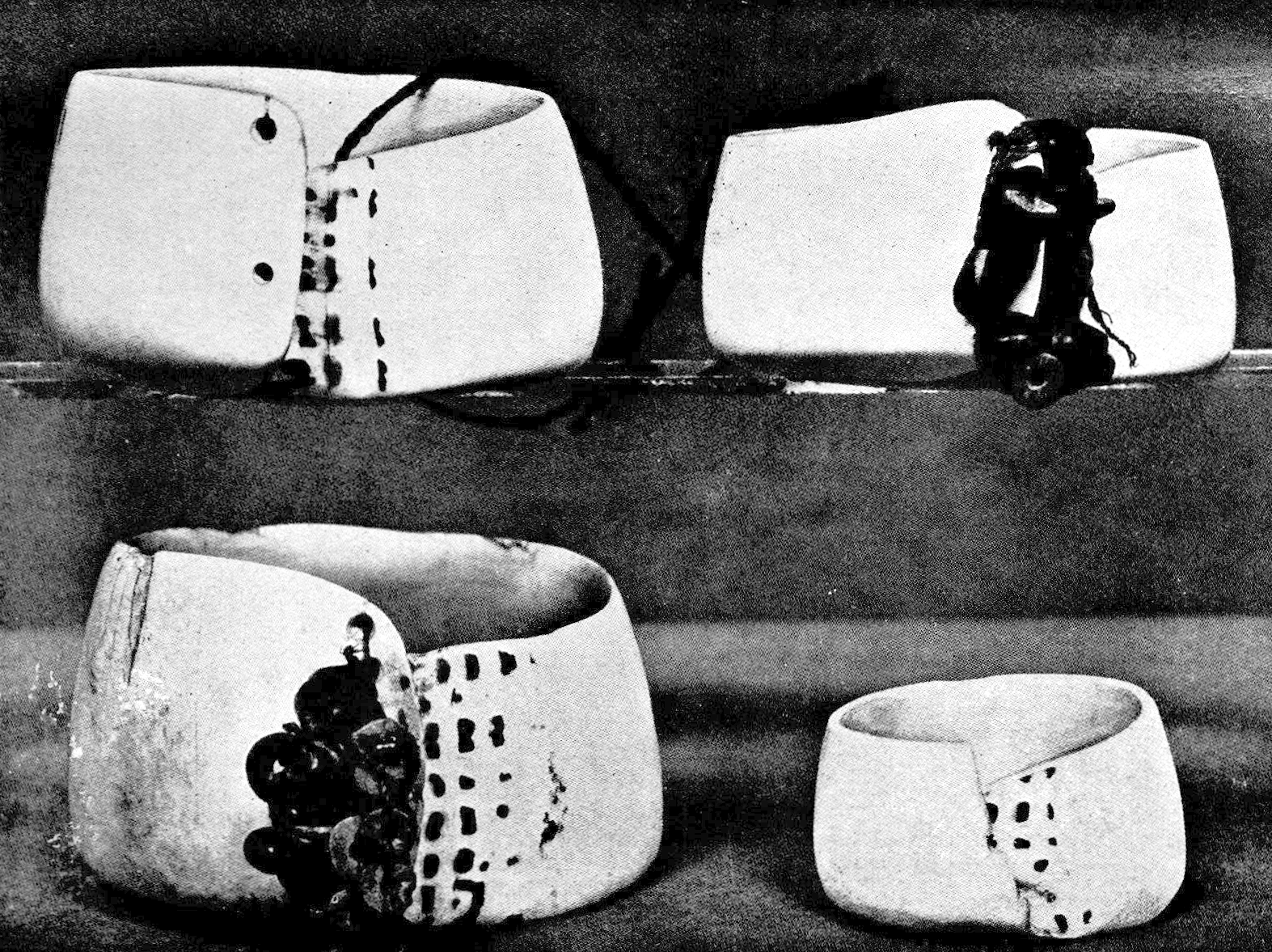 Four mwali, one of the two main kinds of objects in Melanesia's Kula ritual. Photo in Malinowski's Argonauts of the Western Pacific (1922). 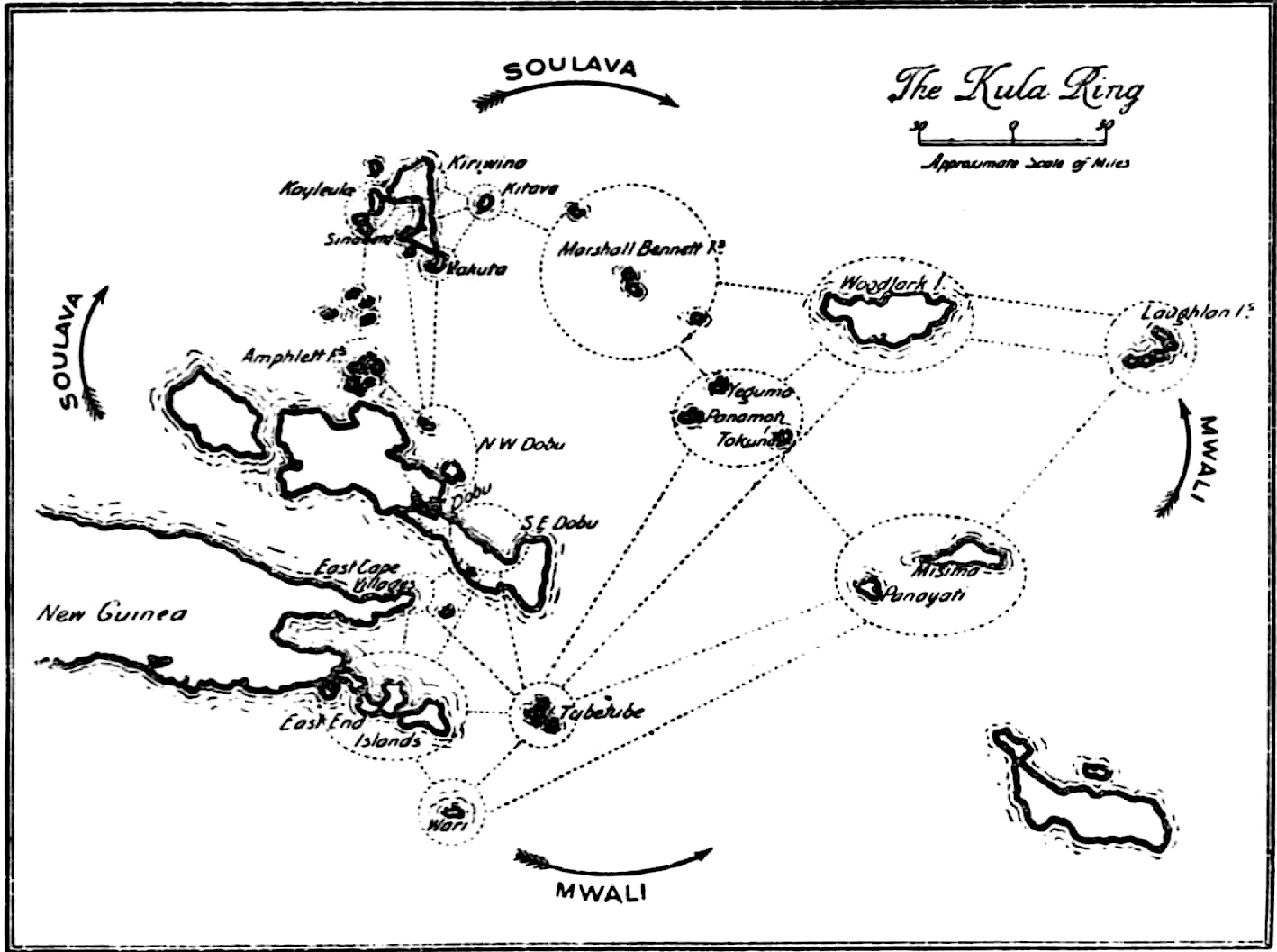 Malinowski in his pioneering[d] research set up a tent in the middle of villages he studied, in which he lived for extended periods of time, weeks or months.[14]: 138 [44]: 20 [40]: 361 His argument was shaped by his initial experiences as an anthropologist in the mid-1910s in Australia and Oceania, where during his first field trip he found himself grossly unprepared for it, due to not knowing the language of the people he set to study, nor being able to observe their daily customs sufficiently (during that initial trip, he was lodged with a local missionary and just made daily trips to the village, an endeavor which became increasingly difficult once he lost his translator).[45]: 1182–1183 His pioneering decision to subsequently immerse himself in the life of the natives represents his solution to this problem, and was the message he addressed to new, young anthropologists, aiming to both improve their experience and allow them to produce better data.[34]: 22 He advocated that stance from his very first publications, which were often harshly critical of those of his elders in the field of anthropology, who did most of their writing based on second-handed accounts.[12]: 335 [15]: 10–14 [46] This could be seen in the relation between Frazer - an influential early anthropologist, nonetheless described as the classic armchair scholar[35]: 17 - and Malinowski was complex; Frazer was one of Malinowski's mentors and supporters, and his work is credited with inspiring young Malinowski to become an anthropologist.[15]: 9 At the same time, Malinowski was critical of Frazer from his early days, and it has been suggested that what he learned from Frazer was not "how to be an anthropologist" but "how not to do anthropology".[46] Ian Jarvie wrote that many of Malinowski's writing represented an "attack" on Frazer's school of fieldwork,[47]: 43 although James A. Boon suggested this conflict has been exaggerated.[15]: 10–14 His early works also contributed to scientific study of sex, previously restricted due to Euro-American prudery and views on morality. Malinowski's interest in the topic has been attributed to his Slavic background having made him less concerned with "Anglo-Saxon puritanism".[8] Functionalism and other theories Malinowski has been credited with originating, or being one of the main originators of, the school of social anthropology known as functionalism.[12]: 335 It has been suggested that he was here inspired by the views of William James.[14]: 137 In contrast to Alfred Radcliffe-Brown's structural functionalism, Malinowski's psychological functionalism held that culture functioned to meet the needs of individuals rather than the needs of society as a whole. He reasoned that when the needs of individuals, who comprise society, are met, then the needs of society are met.[8][24][48]: 166 [49]: 386 Malinowski understood basic needs as arising from the necessities of biology; and culture, as group cooperation – as a way of addressing the basic needs. Thus, biological needs include metabolism, reproduction, bodily comforts, safety, movement, growth, and health; and the corresponding cultural responses are a food supply, kinship, shelter, protection, activities, training, and hygiene.[24] The development of Malinowski's theory of psychological functionalism was intimately tied to his focus on the importance of fieldwork: the anthropologist must, via empirical observation, investigate the functions of the customs observed in the present.[8] To Malinowski, people's feelings and motives were crucial to understanding the way their society functioned, which he outlined as follows:[50] Besides the firm outline of tribal constitution and crystallized cultural items which form the skeleton, besides the data of daily life and ordinary behavior, which are, so to speak, its flesh and blood, there is still to be recorded the spirit—the natives' views and opinions and utterances. — Argonauts, p. 22. Malinowski, in what is considered an important contribution to cross-cultural psychology, challenged the claim, to universality, of Freud's theory of the Oedipus complex.[39] Malinowski initiated a cross-cultural approach in Sex and Repression in Savage Society (1927), demonstrating that specific psychological complexes are not universal.[51]: 28 In 1920 he published his first scientific article on the Kula ring.[14]: 138 [52] In reference to the Kula ring, he later wrote: Yet it must be remembered that what appears to us an extensive, complicated, and yet well ordered institution is the outcome of so many doings and pursuits, carried on by savages, who have no laws or aims or charters definitely laid down. They have no knowledge of the total outline of any of their social structure. They know their own motives, know the purpose of individual actions and the rules which apply to them, but how, out of these, the whole collective institution shapes, this is beyond their mental range. Not even the most intelligent native has any clear idea of the Kula as a big, organised social construction, still less of its sociological function and implications...The integration of all the details observed, the achievement of a sociological synthesis of all the various, relevant symptoms, is the task of the Ethnographer... the Ethnographer has to construct the picture of the big institution, very much as the physicist constructs his theory from the experimental data, which always have been within reach of everybody, but needed a consistent interpretation.[53] 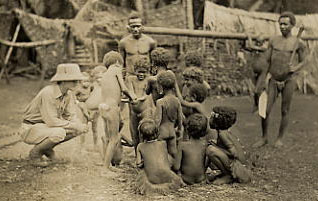 Malinowski with Trobriand Islanders, 1918 In these two passages, Malinowski anticipated the distinction between description and analysis, and between the views of actors and analysts. This distinction continues to inform anthropological methods and theories.[14]: 141 [54]: 200–221 His research on the Trobriand traditional economy, with its particular focus on magic and magicians, has been described as a substantial contribution to economic anthropology.[14]: 138–139 Overall, Malinowski has been credited with "contesting existing stereotypes", such as dismissals of "primitive economics", through his study of the Kula ring, which demonstrated how economics was embedded in culture. He criticized the term "primitive superstition", demonstrating complex relations among magic, science, and religion. Likewise his study of sexuality undermined simplistic views of "primitive sexuality".[37] Malinowski influenced African studies, serving as academic mentor to Jomo Kenyatta, the father and first president of modern Kenya. Malinowski wrote the introduction to Facing Mount Kenya, Kenyatta's ethnographic study of the Kikuyu.[55] Many of Malinowski's students worked in Africa, likely due to his involvement with the International African Institute.[37] Teacher Malinowski is considered to have raised the next generation of anthropologists, particularly British.[12]: 335 Many of his students adopted his functionalist approach.[8] As a teacher, he preferred lectures to discussions;[12]: 335 his seminars have been called "electrifying".[8] He has been praised for his friendly and egalitarian attitude towards women students.[1] Among his students were such future social scientists as Hilda Beemer Kuper,[1][56] Edith Clarke,[1] Kazimierz Dobrowolski,[12]: 335 Raymond Firth,[1] Meyer Fortes,[57]: x Feliks Gross,[12]: 335 Francis L. K. Hsu,[58]: 13 Phyllis Kaberry,[59] Jomo Kenyatta,[60] Edmund Leach,[61]: 1 Lucy Mair,[1] Z. K. Matthews,[62] Józef Obrębski,[12]: 335 Maria Ossowska,[12]: 335 Stanisław Ossowski,[12]: 335 Ralph Piddington,[63]: 67 Hortense Powdermaker,[1] E. E. Evans-Pritchard,[1] Margaret Read,[1] Audrey Richards,[1] Isaac Schapera,[1] Andrzej Jan Waligórski,[12]: 335 Camilla Wedgwood,[1] Monica Wilson[1] and Fei Xiaotong.[12]: 335 |
思想と影響 クライド・クラックホーンは、彼の死後1年が経過した時点ですで に、この分野における彼の影響力は、多少議論の余地があるにせよ、重要なものであったと評しており、一部の人々にとっては「主要な預言者」であり、「人類 学者でこれほど広く一般に支持された人物はいない」と述べている[31]: 335 マイケル・W・ヤングは、マリノフスキーの主な貢献を、親族関係、結婚、家族、呪術、神話、宗教の概念の比較研究であると概説している。彼の研究は、経済 人類学、比較法学、語用論的言語理論など多くの分野に影響を与えた[8]。 民族学とフィールドワーク マリノフスキーは人類学で最も熟練した民族誌学者であり、特に社会システムの研究に対する高度に方法論的で理論化されたアプローチを持っていた。彼はしば しば、人類学を「ベランダから」持ち出した最初の研究者(この言葉は、1986年にアンドレ・シンガーが彼の仕事[c]を描いたドキュメンタリー映画の題 名にもなっている)、つまり、研究者が対象者とともにその日常生活を体験することを可能にするフィールドワークの必要性を強調した研究者と呼ばれる。マリ ノフスキーは詳細な参加者観察の重要性を強調し、人類学者が異文化を理解する上で重要な「日常生活の不可解さ」を適切に記録するためには、情報提供者と日 常的に接触しなければならないと主張した[15]: 10 [33][34]: 22 [35]: 74 人類学者(民族誌学者)の目標は「原住民の視点、生活との関係を把握し、彼の世界観を実現すること」であると述べている。 [36]。彼の議論の影響力の大きさから、特にイギリスでは、マリノフスキーは民族誌という分野を発明したと評価されることもある[37]。  4つのムワリ。メラネシアのクラ儀礼における2種類の主要な物のひとつ。写真はマリノフスキーの『西太平洋のアルゴノーツ』(1922年)所収。  マリノフスキーはその先駆的な[d]調査において、調査対象の村々の真ん中にテントを張り、そこで数週間から数ヶ月という長期にわたって生活した [14]: 138 [44]: 20 [40]: 361 彼の主張は、1910年代半ばに人類学者としてオーストラリアとオセアニアで行った最初の経験から形成されたもので、最初の野外調査の際に、研究対象とな る人々の言葉を知らず、彼らの日常的な習慣を十分に観察することもできなかったため、自分自身がその準備に著しく欠けていることに気づいた(その最初の旅 行の間、彼は地元の宣教師の家に下宿し、ただ毎日村に出向いたが、通訳を失うとその努力はますます困難になった)[45]: 1182-1183 その後、原住民の生活にどっぷりと浸かるという先駆的な決断は、この問題に対する彼の解決策であり、新しい若い人類学者たちに向けたメッセージであった。 彼は最初の出版物からそのようなスタンスを提唱しており、その出版物はしばしば人類学の分野における彼の長老たちのものに対して厳しく批判的であった: 335 [15]: 10-14 [46] このことは、影響力のある初期の人類学者であり、それにもかかわらず古典的な肘掛け椅子学者[35]と評されるフレイザーとマリノフスキーの関係に見られ る: フレイザーはマリノフスキーの指導者であり支援者の一人であり、彼の研究は若きマリノフスキーに人類学者となるインスピレーションを与えたとされて いる[15]: 9。 [同時に、マリノフスキーは初期からフレイザーに対して批判的であり、彼がフレイザーから学んだのは「人類学者としてのあり方」ではなく「人類学をしては いけない方法」であったと示唆されている[46]。 イアン・ジャーヴィーはマリノフスキーの著作の多くがフレイザーのフィールドワークの学派に対する「攻撃」であったと書いている[47]: 43 しかし、ジェームズ・A・ブーンはこの対立が誇張されていると指摘している[15]: 10-14 マリノフスキーの初期の著作は、それまでヨーロッパ・アメリカ的な嗜好や道徳観によって制限されていた性の科学的研究にも貢献した。マリノフスキーのこの テーマへの関心は、彼のスラブ的背景が「アングロサクソンの純血主義」への関心を薄れさせたことに起因している[8]。 機能主義とその他の理論 マリノフスキーは機能主義として知られる社会人類学の学派を創始した、もしくはその主要な創始者の一人であると信じられている[12]: 335 彼はここでウィリアム・ジェームズの見解に触発されたと示唆されている[14]: 137 アルフレッド・ラドクリフ=ブラウンの構造的機能主義とは対照的に、マリノフスキーの心理的機能主義は、文化は社会全体のニーズよりもむしろ個人のニーズ を満たすために機能するとした。彼は、社会を構成する個人のニーズが満たされれば、社会のニーズも満たされると推論した[8][24][48]: 166 [49]: 386 マリノフスキーは基本的欲求を生物学の必要性から生じるものとして理解し、文化は集団の協力として、基本的欲求に対処する方法として理解した。したがっ て、生物学的欲求には、代謝、生殖、身体的快適さ、安全、移動、成長、健康が含まれ、対応する文化的対応には、食糧供給、親族関係、住居、保護、活動、訓 練、衛生が含まれる[24]。 マリノフスキーの心理学的機能主義の理論の発展は、フィールドワークの重要性に対する彼の焦点と密接に結びついていた:人類学者は経験的な観察を通じて、 現在観察されている習慣の機能を調査しなければならない[8]。 骨格を形成する部族構成の確固たる輪郭と結晶化された文化的項目のほかに、いわばその肉と血である日常生活と通常の行動のデータのほかに、精神、つまり原 住民の見解と意見と発話がまだ記録されている。 - アルゴノーツ』22ページ。 マリノフスキーは、異文化間心理学への重要な貢献とされるものにおいて、フロイトのエディプス・コンプレックス理論の普遍性の主張に異議を唱えた [39]。マリノフスキーは『未開社会における性と抑圧』(1927年)の中で異文化間アプローチを開始し、特定の心理的コンプレックスが普遍的なもので はないことを示した[51]: 28。 1920年、クラ環に関する最初の科学的論文を発表する[14]: 138 [52] クラ環に関して、彼は後にこう書いている: しかし、われわれには広範で複雑で、しかも秩序だった制度に見えるものが、法律も目的も憲章も明確に定めていない未開人によって行われた、非常に多くの行 為と追求の結果であることを忘れてはならない。彼らは社会構造の全体像について何も知らない。彼らは自分自身の動機を知っており、個々の行動の目的も、そ れらに適用される規則も知っているが、それらから集団全体の制度がどのように形成されるかは、彼らの精神的な範囲を超えている。観察されたすべての細部を 統合し、関連するさまざまな症状の社会学的総合を達成することが民族誌学者の仕事である......物理学者が実験データから理論を構築するのと同じよう に、民族誌学者は大きな制度の絵を構築しなければならない。  マリノフスキーとトロブリアンド島民、1918年 この2つの文章において、マリノフスキーは記述と分析、そして行為者と分析者の見解の区別を予期していた。この区別は現在も人類学の方法と理論に影響を与 え続けている[14]: 141 [54]: 200-221 トロブリアンドの伝統経済に関する彼の研究は、特に魔法と魔術師に焦点を当てたものであり、経済人類学への実質的な貢献と評されている[14]: 138 -139 全体として、マリノフスキーは、経済学がいかに文化に埋め込まれているかを実証したクラの指輪の研究を通じて、「原始経済学」を否定するなど、「既存の固 定観念に異議を唱えた」と評価されている。彼は「原始的迷信」という言葉を批判し、魔術、科学、宗教の複雑な関係を示した。同様に、彼のセクシュアリティ の研究は、「原始的なセクシュアリティ」という単純化された見方を覆した[37]。 マリノフスキーはアフリカ研究に影響を与え、近代ケニアの父であり初代大統領であるジョモ・ケニヤッタの学問的指導者としての役割を果たした。マリノフス キーは、ケニヤッタによるキクユ族の民族誌的研究である『ケニア山に面して』の序文を執筆している[55]。マリノフスキーの生徒の多くはアフリカで働い ていたが、これは彼が国際アフリカ研究所に関与していたためと思われる[37]。 教師 マリノフスキーは次世代の人類学者、特にイギリス人を育てたと考えられている[12]: 335 彼の学生の多くは彼の機能主義的なアプローチを採用していた[8]: 335彼のセミナーは「電光石火」と呼ばれている[8]。 彼は女性学生に対する友好的で平等主義的な態度を賞賛されている[1]: 335 Raymond Firth,[1] Meyer Fortes,[57]: x Feliks Gross,[12]: 335 フランシス・L・K・シュー,[58]: 13 フィリス・カベリー、[59] ジョモ・ケニヤッタ、[60] エドモンド・リーチ、[61]: 1 ルーシー・メア、[1] Z. K. マシューズ、[62] ジョゼフ・オブラブスキ、[12]: 335 マリア・オソフスカ、[12]: 335 Stanisław Ossowski,[12]: 335 Ralph Piddington,[63]: 67 Hortense Powdermaker,[1] E. E. Evans-Pritchard,[1] Margaret Read,[1] Audrey Richards,[1] Isaac Schapera,[1] Andrzej Jan Waligórski,[12]: 335 カミラ・ウェッジウッド、[1] モニカ・ウィルソン[1] 、フェイ・シャオトン[12]: 335 |
Remembrance Portrait of Malinowski by Witkacy, 1930 The Malinowski Memorial Lecture, an annual anthropology lecture series at the LSE, inaugurated in 1959, is named after him.[12]: 336 A student-led anthropology magazine at the LSE, The Argonaut, took its name from Malinowski's Argonauts of the Western Pacific.[64] The Society for Applied Anthropology established the Bronislaw Malinowski Award in his honor in 1950. The award was awarded only until 1952, then went on hiatus until being re-established in 1973; it has been awarded annually since.[65]: 1 [66] Stanisław Ignacy Witkiewicz based a character, Duke of Nevermore, from his novel The 622 Downfalls of Bungo or The Demonic Woman (written in the 1910s but not published until 1972) on Malinowski.[12]: 336 In 1957 Raymond Firth edited a book dedicated to the life and work of Malinowski, Man and Culture.[67] Other works about Malinowski have appeared since, such as Michael W. Young's Malinowski: Odyssey of an Anthropologist, 1884–1920 (2004).[68] He is portrayed by Tom Courtenay in the Young Indiana Jones TV movie Treasure of the Peacock's Eye.[69] The life and work of Malinowski is the subject of a documentary film Tales From The Jungle: Malinowski aired by BBC Four channel in 2007.[70] Personal life In his youth he was a close friend of Stanisław Ignacy Witkiewicz, a Polish artist; this friendship had much impact on Malinowski's early life.[8][71][72][73] They had a romantic triangle with Zofia Romer née Dembowska.[74] Throughout his life he gained the reputation of a philanderer.[8] His other friends from his student times included Maria Czaplicka, the first female lecturer in anthropology at Oxford University.[75]: 172 In 1919 Malinowski married Elsie Rosaline Masson, an Australian photographer, writer, and traveler (daughter of David Orme Masson), with whom he had three daughters: Józefa (born 1920), Wanda (born 1922), and Helena (born 1925). Elsie died in 1935, and in 1940 Malinowski married the English painter Valetta Swann.[12]: 336 [14]: 138 Malinowski's daughter Helena Malinowska Wayne wrote several articles on her father's life and a book about her parents.[76][77] While Malinowski was brought up in the Catholic faith, after his mother's death he described himself as agnostic.[1] |
追憶 ヴィトカシーによるマリノフスキーの肖像画、1930年 1959年に始まったLSEの人類学講義シリーズ「マリノフスキー記念講義」は、マリノフスキーにちなんで命名された[12]: 336 LSEの学生主導の人類学雑誌『アルゴノート』は、マリノフスキーの『西太平洋のアルゴノート』からその名を取った[64]。 1950年、応用人類学会はマリノフスキーを記念してブロニスワフ・マリノフスキー賞を設立。この賞は1952年まで授与され、その後1973年に再び創 設されるまで休止していた: 1 [66] スタニスワフ・イグナシ・ヴィトキエヴィッチは、1910年代に書かれたが1972年まで出版されなかった小説『文豪622人の転落』(The 622 Downfalls of Bungo or The Demonic Woman)の登場人物であるネヴァーモア公爵をマリノフスキのモデルにした[12]: 336 1957年、レイモンド・ファースはマリノフスキーの人生と仕事に捧げられた本『人間と文化』を編集した[67]。マリノフスキーに関する他の著作は、マ イケル・W・ヤングの『マリノフスキー』(Malinowski: 人類学者のオデッセイ、1884-1920年』(2004年)などがある[68]。 ヤング・インディ・ジョーンズのテレビ映画『孔雀の目の宝物』では、トム・コートネイが彼を演じている[69]。 マリノフスキーの生涯と仕事は、ドキュメンタリー映画『Tales From The Jungle』の題材となっている: マリノフスキーの人生は、2007年にBBC Fourチャンネルで放映されたドキュメンタリー映画『Tales From The Jungle: Malinowski』の主題となっている[70]。 私生活 若い頃はポーランドの芸術家スタニスワフ・イグナシ・ヴィツキェヴィチと親交があり、この友情はマリノフスキーの初期の人生に大きな影響を与えた[8] [71][72][73]。 学生時代からの友人には、オックスフォード大学で人類学初の女性講師となったマリア・チャプリッカがいる[75]: 172 1919年、マリノフスキーはオーストラリアの写真家、作家、旅行家のエルシィ・ロザリン・マッソン(デイヴィッド・オーム・マッソンの娘)と結婚し、3 人の娘をもうけた: ヨゼファ(1920年生まれ)、ワンダ(1922年生まれ)、ヘレナ(1925年生まれ)。エルシエは1935年に亡くなり、1940年にマリノフスキー はイギリス人画家のヴァレッタ・スワンと結婚した[12]: 336 [14]: 138 マリノフスキの娘であるヘレナ・マリノフスカ・ウェインは、父の生涯に関するいくつかの記事や、両親についての本を執筆している[76][77]。 マリノフスキーはカトリックの信仰を持って育ったが、母の死後は不可知論者であると自称していた[1]。 |
| Malinowski, B. (1913). The
family among the Australian Aborigines: a sociological study. London:
University of London Press. ————— (1922). Argonauts of the Western Pacific: An account of native enterprise and adventure in the Archipelagoes of Melanesian New Guinea. London: Routledge and Kegan Paul (Enhanced Edition reissued Long Grove, IL: Waveland Press, 2013). ————— (1926). Myth in primitive psychology. London: Norton. ————— (1926). Crime and custom in savage society. New York: Harcourt, Brace & Co. ————— (1927). Sex and Repression in Savage Society. London: Kegan Paul, Trench, Trubner & Co. ————— H. Ellis (1929). The Sexual Life of Savages in North-Western Melanesia. An Ethnographic Account of Courtship, Marriage, and Family Life Among the Natives of the Trobriand Islands, British New Guinea. London. ————— E.R. Leach; J. Berry (1935). Coral gardens and their magic. London: Allen & Unwin. ————— (1944). A Scientific Theory of Culture and Others Essays. Chapel Hill, N. Carolina: The University of North Carolina Press. ————— (1947). Freedom & Civilization. London. ————— (1946). P.M. Kaberry (ed.). The Dynamics of Culture Change: An Inquiry Into Race Relations in Africa. New Haven: Yale University Press. ————— (1948). Magic, Science and Religion and Other Essays. Glencoe, Illinois: The Free Press (Reissued Long Grove, IL: Waveland Press, 1992). ————— (1962). Sex, Culture, and Myth. New York: Harcourt, Brace & World. ————— (1967). A Diary in the Strict Sense of the Term. New York: Harcourt, Brace & World. ————— (1993). R.J. Thornton & P. Skalnik (ed.). The early writings. Cambridge: Cambridge University Press. |
Malinowski, B. (1913).
オーストラリア原住民の家族:社会学的研究. London: University of London Press. ----- (1922). 西太平洋のアルゴノーツ: An account of native enterprise and adventure in the Archipelagoes of Melanesian New Guinea. London: Routledge and Kegan Paul (Enhanced Edition reissued Long Grove, IL: Waveland Press, 2013). ----- (1926). 原始心理学における神話. London: Norton. ----- (1926). 未開社会における犯罪と習慣。New York: Harcourt, Brace & Co. ----- (1927). 未開社会における性と抑圧. ロンドン: Kegan Paul, Trench, Trubner & Co. ----- H. Ellis (1929). メラネシア北西部における未開人の性生活。An Ethnographic Account of Courtship, Marriage, and Family Life among the Natives of the Trobriand Islands, British New Guinea. ロンドン。 ----- E.R. リーチ; J. ベリー (1935). サンゴの庭とその魔法。ロンドン: Allen & Unwin. ----- (1944). A Scientific Theory of Culture and Others Essays. Chapel Hill, N. Carolina: The University of North Carolina Press. ----- (1947). 自由と文明. London. ----- (1946). P.M. カベリー編. 文化変化の力学: アフリカにおける人種関係の探求. New Haven: Yale University Press. ----- (1948). 魔法・科学・宗教とその他のエッセイ. イリノイ州グレンコー: The Free Press (Reissued Long Grove, IL: Waveland Press, 1992). ----- (1962). 性、文化、神話. New York: Harcourt, Brace & World. ----- (1967). A Diary in the Strict Sense of the Term. ニューヨーク:ハーコート、ブレイス&ワールド。 ----- (1993). R.J. ソーントン & P. スカルニク編. The early writings. ケンブリッジ: Cambridge University Press. |
| https://en.wikipedia.org/wiki/Bronis%C5%82aw_Malinowski |
|
● 死後検証:Raymond Firth ed., Man and culture : an evaluation of the work of Bronislaw Malinowski. Reprint. First published in 1957 by Routledge & Kegan Paul
Bronislaw Malinowski (1884-1942) was one of the most important figures in the development of modern social anthropology. Among the British anthropologists repudiating so-called armchair research, Malinowski was a pioneer of fieldwork. He undertook his long-sustained fieldwork in Papua New Guinea and his accounts are populated by sympathetic figures, described in a deliberately vivid literary style. Malinowski is also recognized as the founder of Functionalism and his ethnographic studies contend that all components of society interlock to form a well-balanced system. This collection reprints the ground breaking studies that emerged from Malinowski's fieldwork. The final volume of the set is an assessment of his contribution to anthropology. This volume is a reassessment of Malinowski's work by a group of his former pupils and colleagues. A frank evaluation, not a eulogy, it examines the real and lasting importance of Malinowski's contribution to a range of subjects.
ブロニスワフ・マリノフスキ(1884-
1942)は、現代社会人類学の発展において最も重要な人物の一人である。いわゆる「書斎での研究」を否定する英国人類学者のなかで、マリノフスキーは
フィールドワークの先駆者であった。彼はパプアニューギニアで長年にわたるフィールドワークを行い、その記録には共感的な人物像が数多く登場し、意図的に
生き生きとした文学的なスタイルで描写されている。マリノフスキーは機能主義の創始者としても知られており、彼のエスノグラフィー研究では、社会のすべて
の構成要素が相互に作用し合い、バランスのとれたシステムを形成していると主張している。このコレクションは、マリノフスキのフィールドワークから生まれ
た画期的な研究を再版したものである。このシリーズの最終巻は、彼の人類学への貢献についての評価である。この巻は、かつての教え子や同僚たちによるマリ
ノフスキの研究の再評価である。賛辞ではなく率直な評価であり、さまざまなテーマに対するマリノフスキの貢献の真の永続的な重要性を検証している。
リンク
参照文献
マリノフスキー文献
マリノフスキーの著作に深く関係する著作 や研究者
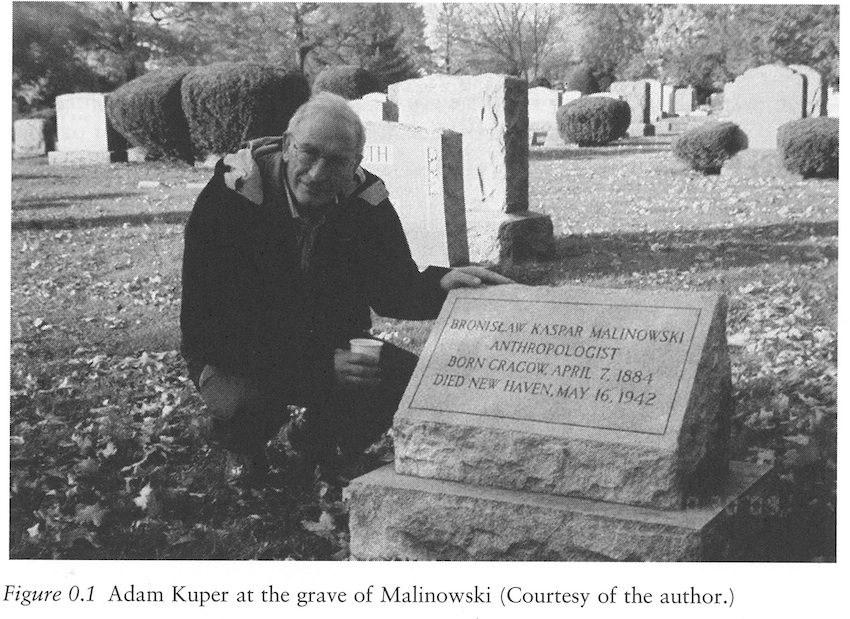
Copyleft,
CC, Mitzub'ixi Quq Chi'j, 1996-2099